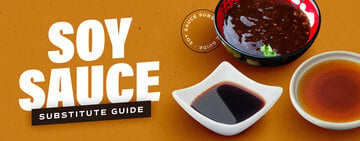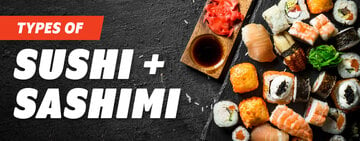Types of Asian Noodles
You can broadly categorize Asian noodles into three main types: wheat, rice, and glass noodles. However, there is a surplus of subcategories with distinct preparation methods, ingredients, shapes, and sizes. Reducing this dynamic cuisine to three unnuanced categories won’t help you navigate the Asian noodle aisle. Our guide to the ten most popular Asian noodles breaks down flavor, texture, and uses so you can find the soft, springy, or slippery Asian noodle that satisfies your needs.
Shop All Asian NoodlesTypes of Noodles with Pictures
Browse our list of the top ten types of noodles with pictures so you can identify them when you shop. While China has more indigenous noodles than any other country, noodles are a staple food throughout Asia. From Thailand and Singapore to Korea and Japan, we explore different types of Asian noodles from various cuisines.
1. Ramen Noodles
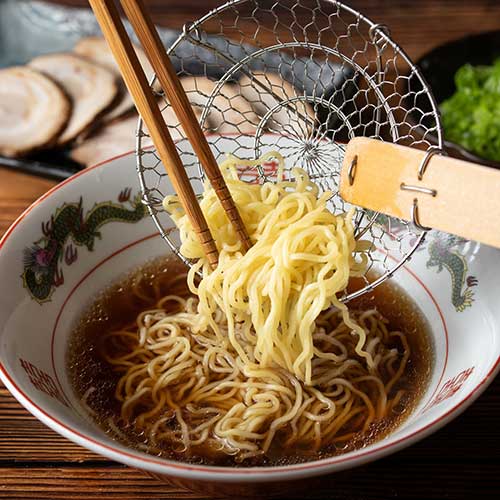
Ramen noodles were made famous by ramen soup, a brothy umami-rich dish loaded with proteins, vegetables, and spices. Ramen noodles are composed of wheat flour, salt, water, and kansui. A type of mineral water, kansui contains sodium carbonate, potassium carbonate, and may contain phosphoric acid.
Kansui imbues ramen noodles with their signature yellow hue and distinguishes them from other types of Japanese noodles. It also stiffens the noodles, inhibiting moisture absorption, and preventing them from becoming soggy in soup recipes.
Texture plays a huge role in the enjoyment of ramen. Ramen’s consistency will vary by its shape and how long you boil it. Each boiling level has a specific name: bari-yawa (extra soft), yawa (soft), futsuu (medium), kata-men (firm), bari-kata (extra firm), and harigane (extra-extra firm). The firmer the noodles, the chewier their texture.
- Ramen Noodle Ingredients - Wheat Flour, Salt, Water, and Kansui
- Ramen Noodle Flavor - Ramen noodles have a salty, mild flavor that lends to any broth.
- Ramen Noodle Texture - Ramen noodles are firm without being crunchy.
- Ramen Noodle Shape - Ramen noodles can be thick, thin, flat, straight, or curly depending on their application.
- Types of Ramen Soup - Categorized by its base flavor, there are four types of ramen noodle soup: shio (salt-based ramen), shoyu (soy sauce-based ramen), miso (soybean paste-flavored ramen), and tonkotsu (pork bone broth ramen).
2. Udon Noodles
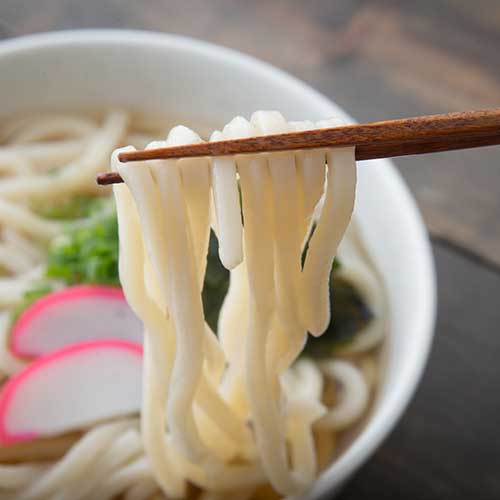
Udon is a Japanese wheat-based noodle with a dense, chewy texture and little flavor. There are regional varieties that range in thickness, smoothness, and width. Udon has a signature white color no matter its regional rendition. You can purchase fresh or dried udon noodles to suit your recipe and storage needs. Dried udon noodles typically resemble fettuccine in shape and size. Fresh udon noodles often have rounder, plumper shapes.
However, niche regions cut their udon into unique shapes. For example, in Aomori and Iwate Prefecture, they cut udon noodles into a signature triangle shape before adding them to mugi kakke soup. In the Tochigi region, they fold udon noodles into an ear shape for mimi udon soup. Mimi udon is a staple of New Year celebrations in the Senba region.
Commonly served in hot broth, udon is considered comfort food. Udon also acts as a base for Japanese curry, is served cold with dipping sauce, and is incorporated in noodle salads. Popular toppings for udon dishes are green onions, shredded seaweed, and Japanese chili flakes. Udon noodles are popular throughout Southeast Asia and are the signature ingredient in the famous Korean dish, jajangmyeon.
- Udon Noodle Ingredients - Wheat Flour, Water
- Udon Noodle Flavor - Udon has a neutral flavor and lends well to spice-laden Asian sauces and broths.
- Udon Noodle Texture - Udon noodles are chewy and soft.
- Udon Noodle Shape - Most udon noodles are thick and long. Fresh udon is typically round, and dried udon is flat.
- Types of Udon Noodles - Hoto, Sanuki Udon, Inaniwa Udon, Kishimen, Ise Udon
Lo Mein vs Udon
The biggest difference between lo mein and udon is that lo mein is made with egg noodles and udon is a wheat noodle. Most udon noodles are wider than lo mein egg noodles. The addition of eggs makes lo mein noodles chewier than udon, and they hold up better in pasta dishes. The plain wheat-based udon noodle absorbs broth and is perfect for soups.
3. Rice Noodles
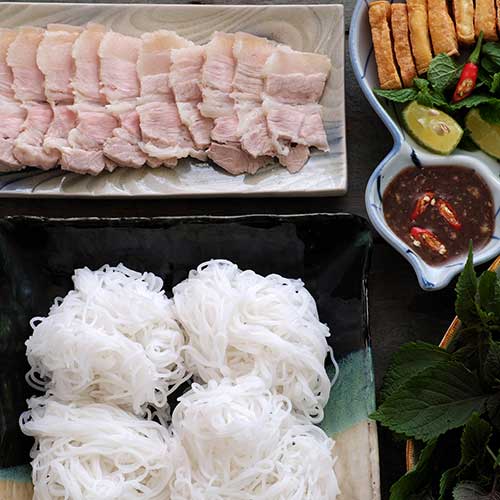
You can loosely categorize Asian rice noodles under the Cantonese word fun or fen. Most Asian rice noodles are made from simple recipes of rice flour and water. From 5 cm long and 5 mm wide silver needle noodles to inch-wide chow fun noodles, Asian rice noodles come in all shapes and sizes. Rice noodles are the staple of many famous dishes like Singapore noodles, pho, and pad Thai. The same basic recipe is used to make rice paper for Vietnamese summer rolls.
How do you cook rice noodles? Rice noodles will cook much faster than wheat-based noodles, but the actual length of time and cooking method depend on whether the rice noodles are fresh or dry. It only takes a couple of minutes to cook fresh rice noodles in warm water. Boiling fresh rice noodles will decimate their delicate composition. You don’t have to cook dried rice noodles at all, simply rehydrate them before adding them to your recipe.
- Rice Noodle Ingredients - Rice Flour, Water
- Rice Noodle Flavor - Rice noodles have a neutral flavor and readily absorb sauces and broths.
- Rice Noodle Texture - Rice noodles have a springy, chewy, and slippery consistency.
- Rice Noodle Shape - The most popular rice noodle variety is flat and long.
- Types of Rice Noodles - Rice Sticks, Rice Vermicelli, Kway Teow, Silver needle, Chow Fun, Chang Fun, Lai Fun
Rice Noodles vs Lo Mein
Lo mein noodles are made of wheat flour, water, and egg. Rice noodles are made with rice flour and water. If you’re looking for a slippery noodle to absorb the flavor of your sauce or broth, then rice noodles are the right choice for you. If you want a chewy, creamy noodle that makes a great base for pasta dishes, then lo mein (or another Chinese egg noodle) is the right fit for your recipe.
4. Soba Noodles
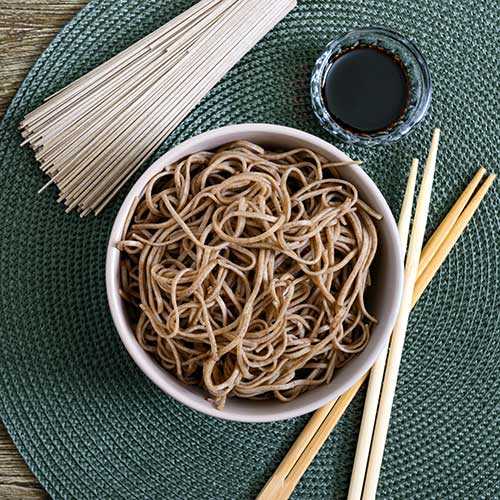
Soba noodles are Japanese noodles made with buckwheat flour and water (soba is the Japanese word for buckwheat). Many varieties use a percentage of whole wheat flour to make the noodles sturdier. Pure buckwheat soba is called ju-wari soba, and 80% buckwheat soba is known as hachi-wari soba. For authentic, high-quality soba noodles, check the label and make sure they have at least 70-80% buckwheat flour.
Soba noodles are higher in protein and fiber than other types of Asian noodles. People use them in hot noodle dishes, cold noodle salads, and brothy noodle soups. Soba noodles are an easy and delicious way to accommodate gluten-free patrons, just make sure the noodles you’re using are 100% buckwheat (ju-wari soba).
- Soba Noodle Ingredients - Buckwheat Flour, Water, Whole-Wheat Flour (sometimes)
- Soba Noodle Flavor - Soba noodles carry a nutty, earthy flavor.
- Soba Noodle Texture - Soba noodles have a chewy, grainy mouthfeel.
- Soba Noodle Shape - Soba noodles are sold in multiple thicknesses. They can be round- or square-shaped.
- Types of Soba Noodles - Ju-Wari Soba, Hachi-Wari Soba, Green Tea Soba, Ume Plum Soba
5. Glass Noodles
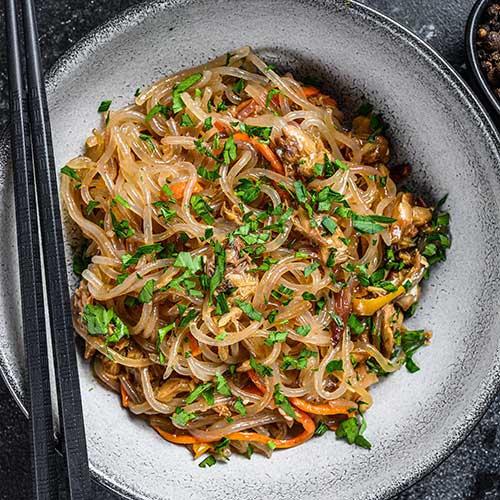
Also known as cellophane noodles or bean thread noodles, glass noodles are skinny, long noodles made from water and starch derived from beans and tubers. Noodle makers use mung bean starch, sweet potato starch, tapioca starch, pea starch, and potato starch to make glass noodles. They are a gluten-free alternative to wheat-based noodles and pasta. Check the label and confirm they weren’t exposed to gluten during manufacturing before purchasing glass noodles for your gluten-free menu.
Glass noodles are not always transparent; their color varies by the starch used. The most common type of glass noodle comes from China and is made with mung bean starch. Glass noodles made from sweet potato starch dominate the Korean and Japanese noodle market. Tapioca noodles are extremely popular in Vietnam and are used to make the Central and Southern Vietnamese dish, crab tapioca noodle soup.
- Glass Noodle Ingredients - Water, Vegetable Starch (commonly mung bean, sweet potato, or tapioca)
- Glass Noodle Flavor - Most glass noodle varieties have a mild flavor with a slight sweetness.
- Glass Noodle Texture - Glass noodles have a gelatinous, slightly chewy consistency.
- Glass Noodle Shape - Most glass noodles are long and thin.
- Types of Glass Noodles - Mung bean starch glass noodles, Sweet potato starch glass noodles, Arrowroot starch glass noodles, Tapioca glass noodles
6. Chow Mein Noodles
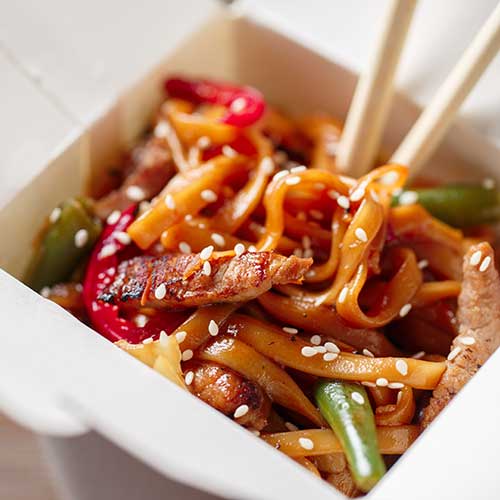
Mein is the Chinese word for noodles, and chow means fried, so chow mein simply means fried noodles. The noodles used in chow mein dishes are usually egg noodles browned in oil on both sides, earning them the nickname “twice-browned noodles". There are two main types of chow mein: steamed chow mein and crispy chow mein. To make steamed chow mein, chefs flash fry the egg noodles before tossing them with the rest of the ingredients and coating them in a light sauce. For crispy chow mein, chefs press the noodles flat while frying them.
The chow mein dish you’ll find on most Chinese food menus was created by Chinese Americans. It evolved from an authentic dish known as ch’ao mien, aka “stir-fried noodles”. In American Chinese cuisine, chow mein is known as a specific dish made with egg noodles, meat, and vegetables bathed in a dark, thick, soy-based sauce.
- Chow Mein Noodle Ingredients - Chow mein noodles are typically egg noodles composed of egg, water, and wheat flour.
- Chow Mein Noodle Flavor - The sauce used for Americanized chow mein dishes masks the noodles’ mild flavor. Composed of soy sauce, oyster sauce, sesame oil, and cornstarch, chow mein sauce offers a mildly sweet, savory flavor profile.
- Chow Mein Noodle Texture - The texture of chow mein noodles ranges from stiff to crunchy depending on how they’re fried.
- Chow Mein Noodle Shape - The noodles used in chow mein can be round or flat.
- Types of Chow Mein Noodles - Choose fresh egg noodles for a softer chow mein dish and dried egg noodles for a crispy chow mein recipe.
Chow Mein vs Lo Mein
The Chinese word mein means noodles, so both chow mein and low mein are noodle dishes. Chow mein translates to “fried noodles” in English and lo mein translates to “stirred or tossed noodles”. Chefs soften chow mein noodles in hot water before adding them to a wok with oil and the other ingredients they’re stir-frying. For lo mein noodles, chefs cook the noodles before mixing them with meat, vegetables, and slathering them in a rich sauce.
7. Vermicelli Noodles
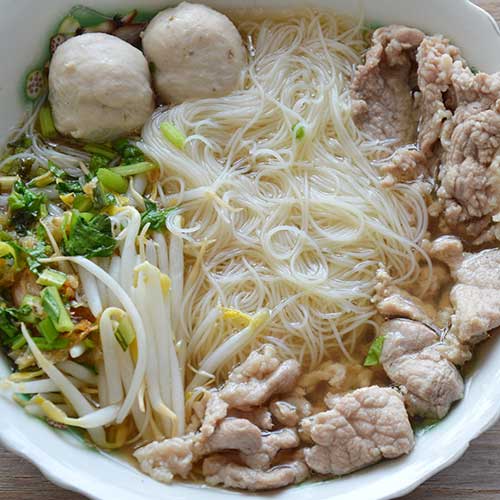
The term vermicelli encompasses a broad category of thin Asian noodles. The noodle must have a diameter of less than 0.06 inches (1.5 mm) to be classified as vermicelli. The most popular type of Asian vermicelli noodle is rice vermicelli. Rice vermicelli noodles are known as bee hoon in Hokkien Chinese, mai fun in Cantonese Chinese, wunsen in Thai, kya zan in Burmese, and bun in Vietnamese.
Since vermicelli designates size, not ingredients, you'll encounter different types of vermicelli noodles dominating regional and national sales landscapes. In Vietnam, vermicelli noodles are the same as angel hair pasta. In China, you’ll find wheat vermicelli (misua) and various mung bean vermicelli noodles. Thailand is famous for its mung bean vermicelli, pad woon sen.
- Vermicelli Noodle Ingredients - There are rice, wheat, mung bean, potato starch, and tapioca vermicelli varieties.
- Vermicelli Noodle Flavor - The flavor of vermicelli noodles varies by type. The most common, rice vermicelli, absorbs the flavor of sauces and broths.
- Vermicelli Noodle Shape - Vermicelli noodles are round, extremely thin (diameter of less than 0.06 inches aka 1.5 mm), and up to 18 inches long.
- Types of Vermicelli Noodles - Misua, Pad Woon Sen, Mai Fun, Bun, Kya Zan
8. Somen Noodles
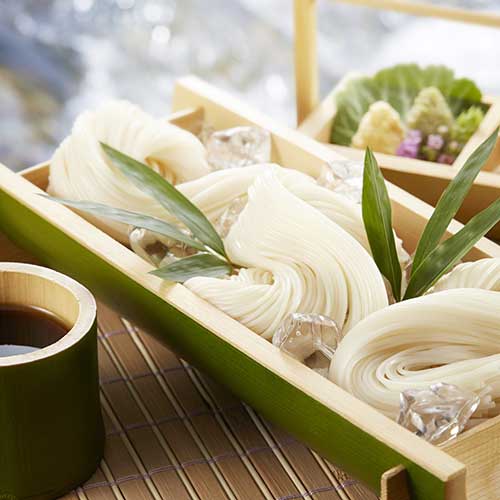
Somen noodles are wispy (less than 0.05 mm in diameter), pale, Japanese wheat noodles made from superfine wheat flour, salt, and water. After it’s hand-stretched into thin strips, somen noodle dough is coated in vegetable oil to prevent over-air-drying. Due to their thread-like consistency, you can cook somen noodles in under 3 minutes in boiling water; because the noodles contain salt, don’t salt the water before boiling them. Once cooked, rinse the somen in cold water to remove the oil.
Summers in Japan are sweltering, and slurping cold somen noodles is a popular way to cool down. Cold somen noodles are dipped in umami-rich tsuyu sauce made by combining soy sauce, rice wine, sake, dried kelp, and dried bonito flakes. Many restaurants create an interactive serving experience known as nagashi somen. Invented after World War II, restaurants serve nagashi somen by dropping somen noodle clusters into a chute of running water. Patrons scoop the somen clusters out of the water with chopsticks as they float down, and then dunk them in a sauce. Somen noodles are enjoyed in hot soups and stir-fries during the colder months.
- Somen Noodle Ingredients - Wheat Flour, Salt, and Water
- Somen Noodle Flavor - Somen noodles have a very mild flavor and are best with a tangy sauce.
- Somen Noodle Texture - Somen noodles have a light and slippery texture.
- Somen Noodle Shape - Somen noodles are cylindrical with a diameter of less than 0.05 mm.
- Types of Somen Noodles - Miwa Somen, Shimabara Somen, Shima No Hikari Somen
9. Chinese Egg Noodles
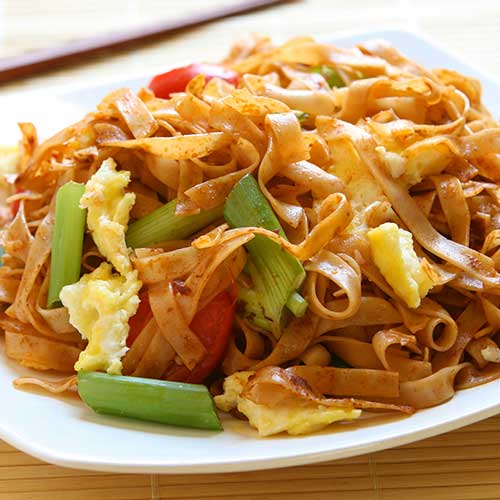
Chinese egg noodles, also known as egg noodles, are timeless Asian noodles composed of wheat flour, water, and eggs. You can find egg noodles shaped into both thick and thin strands. Chinese egg noodles are beloved for their springy, chewy consistency. They are the staple ingredient in classic Chinese meals like chow mein, wonton soup, and lo mein. Some retailers cut corners and use food coloring to tint their noodles instead of eggs, so check ingredient labels to confirm you’re getting authentic egg noodles.
Chinese egg noodles are distinct from the German egg noodle pasta known as spaetzle. Irregularly shaped and short, spaetzle is usually made with semolina flour, milk, and eggs. Spaetzle has a consistency reminiscent of a dumpling. In contrast, classic Chinese egg noodles are long, thin, and uniform. They are either round or flat and provide a springy, chewy texture. You cannot use these two distinct ingredients interchangeably.
- Chinese Egg Noodle Ingredients - Wheat Flour, Water, and Egg
- Chinese Egg Noodle Flavor - Egg noodles offer a slightly creamy mouthfeel, but they carry little flavor.
- Chinese Egg Noodle Texture - Egg noodles have a springy, chewy consistency.
- Chinese Egg Noodle Shape - Popular Chinese egg noodles come in long strands that are either thin like spaghetti or flat like linguine.
- Types of Chinese Egg Noodles - Chow Mein Noo, Lo Mein, Thin Wonton Noodles, Wide Wonton Noodles
10. Kal-Guksoo Noodles
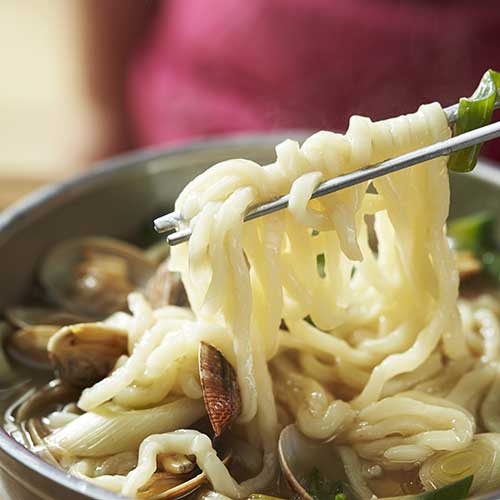
Kal-Guksoo is a Korean noodle made from wheat flour, water, and eggs distinct from Chinese egg noodles due to their preparation method. Korean noodle makers roll kal-guksoo dough into a thin rectangle and then slice it into ribbons with a knife. Kal-guksoo translates to knife noodles in English, since they are cut rather than strung or spun. Some kal-guksoo varieties incorporate dried bean powder or mashed mung beans into their dough as thickening agents.
Kal-guksoo is considered a summer seasonal food. It’s usually served in a large bowl with broth and other ingredients like shellfish and vegetables. The traditional broth for kal-guksoo is composed of shellfish, kelp, and dried anchovies. Chicken broth would be the second most popular choice. Chefs build a rich flavor by slowly simmering kal-guksoo broth. Kal-guksoo noodles are either boiled in the broth alongside popular Korean vegetables like zucchini, potatoes, and scallions or they’re added at the end. This mild soup is often served with kimchi for added flavor.
- Kal-guksoo Noodle Ingredients - Wheat Flour, Water, and Eggs
- Kal-guksoo Noodle Flavor - Kal-guksoo noodles have a mild and creamy flavor.
- Kal-guksoo Noodle Texture - Kal-guksoo noodles have a doughy, bouncy consistency.
- Kal-guksoo Noodle Shape - Kal-guksoo noodles have a long, flat shape.
- Types of Kal-guksoo Noodles - Mung Bean Kal-guksoo, Hobak Pumpkin Kal-guksoo, Perilla Seed Kal-guksoo, Millet Kal-guksoo
Asian Noodles FAQs
Now that you have a grasp of the most popular types of Asian noodles, you probably have additional questions about how they’re cooked and the nuances between them. From where to buy Asian noodles to how long they’ll last, we answer chefs' most frequently asked Asian noodle questions below.
How Are Noodles Made?
Today, most grand-scale noodle manufacturers use the roll and cut method to make their noodles. To perform the roll and cut method, noodle dough is salted, thoroughly kneaded, and rested. Once it reaches its desired consistency, the noodle dough is sent through a series of rollers and transformed into a long sheet. The final roller has a cutter attached to it, which the manufacturer can adjust to customize thickness. The noodle sheet is cut into two-meter-long strands. These 2-meter-long ribbons are moved to a drying room where they are left to naturally air dry. After a minimum of 30 hours have passed, the noodle ribbons are cut and packaged. While time-consuming, the labor of love provides rich flavor and aids digestion.
How Long Do Fresh Noodles Last?
Fresh noodles will last between three and four days in the fridge. You can purchase fresh-frozen noodles that will last several months in your freezer.
How Long Do Dry Noodles Last?
Dry noodles will taste best if you use them within six or seven months of purchasing them. Preserve their quality by storing them in a cool, arid area.
Where to Buy Asian Noodles?
In years past, you would have to visit an Asian market to buy Asian noodles in the US. As they’ve risen in popularity and charmed the American palate, many of the most popular Asian noodles are available on the international foods aisle at large grocery outlets. One of the most cost-effective ways to stock up on Asian noodles is to order them online from a restaurant retailer like WebstaurantStore. You’ll get easy access to a broad selection with the convenience of having them delivered straight to you.
Pasta vs Noodles
People often confuse pasta and noodles. Pasta, the signature dish of Italy, is made from durum semolina, a tetraploid species of wheat with a yellow endosperm and a coarser texture than common wheat. Pasta artisans extrude pasta dough into various shapes by forcing the dough through a shaped opening (not unlike what you did as a child with Play-Doh). In contrast, Asian noodle makers string, spin, or cut their noodles. Traditionally, Asian noodles are made with flour milled from common wheat, rice flour, or starch from a tuber or bean. Because traditional Asian noodles use softer flours and starches than pasta, most noodles employ salt as a binding agent, whereas Italian pasta typically forgoes salt.
According to a Pew Research Center report, the Asian population is the fastest-growing racial group in America. Pair this demographic reality with food trends toward healthier eating and globally-inspired cuisine, and it’s no wonder that Asian-inspired dishes are dominating the food landscape. Greasy, Americanized Chinese food isn't the only Asian food option anymore. The modern consumer is looking for nourishing dishes, global fusion-style meals, and favors authentic Asian ingredients. Use our guide to the best Asian noodles to revamp your menu and meet the growing demand.

